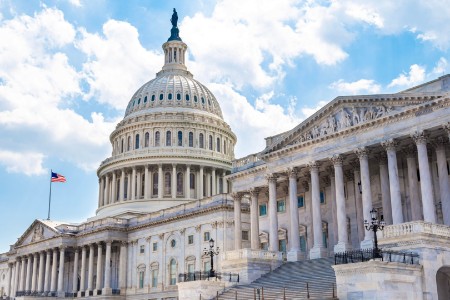
Chapter
Overview of COVID-19 waiver authority
The federal government has broad authority to issue emergency declarations that provide federal agencies with the flexibility to respond to PHEs.
In response to the pandemic, the federal government invoked statutory authority to declare emergencies enabling agencies and states to waive or modify requirements for federal health care and workforce requirements. In addition, Congress throughout the pandemic has passed legislation that broadened HHS’s authority to waive certain regulations in the wake of a PHE and has amended statutes to directly provide or extend flexibilities related to the pandemic. Below is an overview of the major emergency declarations and legislation that provided the COVID-19 waiver authority.
Emergency declarations
Federal legislation

Chapter
Telehealth and home health
Telehealth providers, suppliers and vendors must act now to understand and comply with the patchwork of state and federal telehealth regulations that will exist when the PHE ends.
Regulatory authority over telehealth varies by the type of plan: The federal government directly oversees Medicare and self-insured plans, while Medicaid and fully insured health plans are subject to both federal and state requirements. Throughout the PHE, the Trump and Biden administrations, Congress, states, and private payers took steps to increase access to telehealth and home health services to ease the burden on hospitals and providers overrun with COVID-19 patients and to protect patients and providers from unnecessary exposure from in-person visits.
As a result, telehealth use in 2020 soared among both privately and publicly insured patients, particularly for mental health and substance use disorders. And while telehealth utilization rates have declined since the early days of the pandemic, they remain well above pre-pandemic levels and are now an expected care option among patients.
For the past year, states have been rolling back their emergency declarations and health care-related flexibilities. There is now a national conversation occurring in both the federal and state legislatures around which COVID-19 flexibilities should remain in place long term, with many of those conversations centered on telehealth. In many cases, providers’ and payers’ ability to continue offering telehealth services will depend on the future regulatory, legislative and payment landscape at both the state and federal level.
Telehealth waiver trends at the federal level
At the federal level, continued telehealth use requires both regulatory and legislative changes, and the Biden administration and lawmakers have been actively engaged in these discussions. Congress has already acted to temporarily extend certain federal telehealth waivers and is currently considering which telehealth flexibilities to extend further. In addition, CMS is conducting a regulatory review to identify areas where it has the legal authority and the supporting evidence to extend or make permanent certain telehealth flexibilities.
The key concerns policymakers are working to address are overall costs and offsets, health equity, payment parity, modality and geographic location restrictions, quality of care, audio-only care, and the impact on fraud, waste and abuse. For example, the Congressional Budget Office (CBO) estimated that extending certain telehealth policies just five months would cost $633 million. The Committee for a Responsible Federal Budget extrapolated that figure forward, predicting a cost of $25 billion for 10 years.
The table below outlines key federal telehealth flexibilities enacted during the pandemic:
Telehealth waiver trends at the state level
Throughout the pandemic, all 50 states and Washington, DC declared states of emergency, which gave state governments the authority to expand telehealth access through Medicaid/CHIP and commercial insurers. CMS issued a toolkit encouraging state Medicaid agencies to adopt many of the agency’s Medicare waivers. And while many state agencies expanded their telehealth policies, some of those authorities are tied to their state declarations, which many states have since rolled back: As of February 2023, 8 states still had emergency orders in place.
States that wish to permanently keep some of the COVID-19-era telehealth policies generally have broad flexibility to determine whether to cover telehealth, which services to cover, the geographic regions in which telehealth may be used and how to reimburse providers for these services. In some cases, they may need to work with CMS to submit state plan amendments or apply for home and community-based services waivers (1915(c)). And some states have already moved to make certain telehealth changes permanent. For example, at least 21 states have implemented laws requiring payment parity between telehealth and in-person visits, and most states have permanently adopted Medicaid coverage for audio-only behavioral health consultations.
Many commercial insurers also voluntarily expanded access to telehealth visits at the start of the COVID-19 pandemic, authorizing no- or low-cost sharing for telehealth services and provider payment parity with in-person visits. But as the pandemic continued, many insurers began rolling back those reimbursement-related policies. In other cases, commercial insurers have made permanent changes to their reimbursement policies to cover certain routine virtual visits, audio-only visits and behavioral visits.

Chapter
Health care coverage and affordability
The makeup of the health insurance market is poised to shift as Medicaid redeterminations ensue.
Throughout the COVID-19 pandemic, federal legislators and regulators have taken steps to pass new or modify existing health care coverage and affordability provisions to promote stability and affordability of health care coverage due to concerns over employer-sponsored coverage losses and inadequate access to affordable coverage care. Those changes took aim at individuals and families in Medicaid, the individual market and the group market. For example, congressional Democrats and the Biden administration extended enhanced ACA subsidies for marketplace enrollees through 2025 under the IRA. In addition, on January 27, 2023, CMS announced a 16-month special exchange enrollment period to allow the estimated 5 million to 15 million individuals who could lose Medicaid coverage as part of the redetermination process an opportunity to enroll in a marketplace plan.
Estimated Change in Medicaid Enrollees from FY 2022 to FY 2023, by Enrollment Scenario
Number of People Eligible for Marketplace Subsidies Before and After American Rescue Plan Act
The below table explores some of the most discussed pandemic health insurance coverage policies and their expected end dates:

Chapter
Provider relief and flexibilities
As pandemic relief funds run dry and pre-pandemic budgetary cuts resume, providers should look to post-pandemic revenue streams, including boosting patient volumes and optimizing high-reimbursement services.
Scattered throughout pandemic relief packages and regulatory flexibilities, there was an influx of funding and other policies aimed at alleviating the financial impact of COVID-19 on hospitals and providers. However, much of this flexibility and funding has now run dry — or close to it — and other cuts that were staved off are coming back online.
COVID-19 relief funds that are set to end include:
- Provider relief funding: $178 billion in provider relief allocated through the Provider Relief Fund (established under the CARES Act) in addition to $8.5 billion in American Rescue Plan (ARP) rural funds to hospitals and other providers has nearly all been allocated, with slim chances of being reupped. Hospitals and other providers also benefitted from other pandemic programs such as the Paycheck Protection Program, which MedPAC estimated provided nearly $100 billion to health care providers. CMS also expanded the COVID-19 Accelerated and Advance Payments (CAAP) Program, and Congress advanced additional flexibilities; however, CMS stopped accepting applications as of October 2020 for accelerated or advance payments as they relate to the COVID-19 PHE and has begun to recoup payment despite pressure from industry for additional delay.
- Increased payments for vaccines and treatments: During the PHE, Medicare increased all inpatient reimbursement for COVID-19 patients by 20% during the PHE through April 14, 2022, created the New COVID-19 Treatment Add-on Payment (NCTAP) policy enabling eligible providers in the inpatient setting to receive additional payments for certain COVID-19 treatments, and increased reimbursement for COVID-19 vaccine administration. For the uninsured and underinsured, a portion of the Provider Relief Funds are being used to reimburse providers for administering COVID-19 vaccines to uninsured or underinsured individuals. CMS in the fiscal year 2022 Inpatient Prospective Payment System rule extended the NCTAP through the end of the year in which the PHE expires and the 20% add-on payment is expected to sunset with the PHE on May 11.
In addition, providers throughout the pandemic have seen relief from statutory cuts to their Medicare payments, including 2% sequester cuts and annual payment bumps to the Medicare Physician Fee Schedule’s conversion factor. However, some of those cuts have already been phased back in.

Sources: CAA 2023; CMS MLN Connects, 16 December 2023; MPFS CY 2023 final rule; Protecting Medicare and American Farmers from Sequester Cuts Act
Payment rule flexibilities and quality reporting
CMS implemented multiple flexibilities and measure suppression policies aimed at mitigating negative financial impacts due to COVID-19 and reducing provider reporting burden during the PHE. CMS announced the agency will continue to use its Extreme and Uncontrollable Circumstances policy to allow clinicians, groups and virtual groups to submit an application requesting reweighting of one or more Merit-based Incentive Payment System (MIPS) performance categories for the 2023 performance year due to the COVID-19 PHE.20
Additionally, CMS has implemented a policy that enables the agency to suppress, or not use, certain quality measures that the agency believes may have been impacted by providers’ COVID-19 response efforts. However, CMS through annual rulemaking has indicated that most measure suppression policies will expire after the 2023 performance year, indicating participants could be subject to all quality program requirements effective 2024. In addition, for the Hospital Readmissions Reduction Program, CMS announced a new a covariate adjustment for patient history of COVID-19 in the 12 months prior to admission for each of the six condition-/ procedure-specific measures beginning in 2024.
| Quality program | Measures suppressed for 2023 |
Details |
| Hospital Readmissions Reduction Program (HRRP) |
Source: FY 2023 Inpatient Prospective Payment System (IPPS) final rule |
CMS calculates the measure’s rate for the program year but zeroes out the weight when calculating scores. |
| Hospital Value-Based Purchasing (VBP) Program |
CMS will resume use of NQF #0468 in the 2024 performance year. Source: |
CMS would calculate all measure rates for FY 2023 and would exclude suppressed measures from final scoring. Based on this, CMS would give a neutral payment. CMS notes that its scoring methodology could impact providers’ MIPS performance for the CY 2022 and 2023 performance periods and subsequent payment periods. CMS said it intends to resume using measure data for scoring and payment adjustments in the FY 2024 performance year. |
| Hospital Acquired Condition (HAC) Reduction Program |
Source: |
Hospitals will not receive a penalty for FY 2023 or a total HAC score. |
| Skilled Nursing Facility (SNF) Value-Based Purchasing Program |
Source: |
For FY 2022, CMS assigned all SNFs a performance score of 0, ranking all facilities equally. For FY 2023, measure performance will be publicly reported but will not impact payment. |
| End-Stage Renal Disease Quality Incentive Program |
Sources: CY 2022 End Stage Renal Disease Prospective Payment System final rule, fact sheet |
CMS will not score the suppressed measures for PY 2023 but will provide confidential feedback reports to facilities on their measure rates, which will be based on 2019 data. CMS will also publicly report the suppressed data with caveats related to the PHE. |

Chapter
Coverage of diagnostics, treatments and vaccines
Providers relying on COVID-19 treatments under EUA should begin to think through post-PHE treatment plans, while consumers will need to familiarize themselves with their insurer’s cost-sharing policies related to COVID-19.
Emergency Use Authorization
Emergency Use Authorization (EUA) authority allows the FDA to facilitate availability and unapproved uses of medical countermeasures (MCMs) needed to prepare for and respond to public health, military and domestic emergencies involving chemical, biological, radiological and nuclear (CBRN) agents, including emerging infectious disease threats. Throughout the PHE, the FDA has issued hundreds of EUAs for COVID-19 tests and treatments for use before formal FDA approval, as well as four COVID-19 vaccines.
As of December 2022, the FDA has approved two COVID-19 vaccines (Pfizer-BioNTech’s Comirnaty and Moderna’s Spikevax) and three drugs (the antiviral drug Veklury and the immune modulators Olumiant and Actemra) to treat COVID-19 in certain populations. The FDA maintains a full list of COVID-19 approved and authorized vaccines, treatments and medical devices here. FDA in recent guidance indicated the end of the PHE will not impact existing EUAs or the FDA’s ability to authorize new products and devices under emergency use.
Cost-sharing and coverage provisions
Throughout the pandemic, the federal government has purchased COVID-19 tests, treatments and vaccines and made them available to individuals at no cost, regardless of their insurance status through pharmacies, community health centers, federal sites, and allocations to states and localities. The availability of these government-purchased supplies has been instrumental in supporting large-scale testing and vaccination efforts and enhancing access to underserved communities. In addition, the Health Resources and Services Administration (HRSA) oversees a program called the COVID-19 Uninsured Program (UIP) to reimburse providers for testing, treatment and vaccines for uninsured patients. However, funding for the uninsured program has run dry, as Congress declined to pass additional COVID-19 relief packages. The HRSA stopped accepting claims for testing and treatment on March 22, 2022, and claims for vaccine administration at on April 5, 2022, due to a lack of sufficient funds. In April 2023, HHS unveiled the $1.1 billion Bridge Access Program for COVID-19 Vaccines and Treatments, a public-private partnership to ensure uninsured individuals can access no-cost COVID-19 vaccines and treatments beyond the PHE. HHS said it will fund the program through December 2024 with existing COVID-19 supplemental funds. The Biden administration also announced plans to launch a $5 billion-plus program, called “Project Next Gen,” to partner with private-sector companies to accelerate the development of new coronavirus vaccines and treatments.
The lack of new federal funding for COVID-19 vaccines and treatments and the looming end to the PHE will mark a shift from government to commercial in terms of coverage and spending. It’s expected that COVID-19 vaccines will continue to be available at no cost to those with public and private insurance, but cost sharing is likely to return for COVID-19 treatments and tests. The CAA 2023 includes a provision to ensure Medicare Part D temporarily covers oral antiviral treatments, even if they are only available through EUAs. However, those treatments may not be available to those with commercial coverage temporarily, because generally plans cannot cover treatments without FDA approval. Below is an overview of coverage policies for Medicare, Medicaid and the commercial market.
| Pandemic coverage policy | Medicare | Medicaid | Commercial market |
| Over-the-counter testing | Medicare beneficiaries can get up to eight tests per calendar month from participating pharmacies and health care providers. This requirement is voluntary for Medicare Advantage plans. Expiration: End of the PHE. |
Medicaid covers at-home COVID-19 testing without cost-sharing. Expiration: Last day of the first calendar quarter beginning one year after PHE ends, which would be September 30, 2024 if the PHE ends on May 11. |
Private insurers are required to cover up to eight FDA-authorized rapid at-home COVID-19 tests purchased over the counter. |
| Diagnostic testing | Medicare Part B provides diagnostic COVID-19 testing and testing-related services with no cost sharing. Medicare Advantage plans are required to cover all Medicare Part A and Part B services, including COVID-19 lab tests. Expiration: Medicare will continue to cover provider-ordered COVID-19 tests that are analyzed in a laboratory beyond the PHE. However, MA plans could resume cost sharing when the PHE ends. |
Medicaid is required to cover COVID-19 testing and treatment services for enrollees with no cost sharing. |
Private insurers are required to cover COVID-19 testing without cost sharing and insurers are prohibited from requiring prior authorization for COVID-19 testing. Short-term limited duration plans are exempt from this requirement, but encouraged to do so. |
| Treatments | Medicare covers monoclonal antibody infusions authorized for use by the FDA under EUA and beneficiaries currently face no cost sharing for this treatment, which could change once the PHE ends. |
Medicaid is required to cover COVID-19 treatment services for most enrollees with no cost sharing. |
No special financial protections for COVID-19 treatment. Some insurers voluntarily waived cost sharing for COVID-19 treatment early in the pandemic. |
| Vaccines | Medicare will cover the COVID-19 vaccine under Part B with no cost sharing for the vaccine or its administration for Medicare beneficiaries in both traditional Medicare and Medicare Advantage plans. |
Medicaid must cover COVID-19 vaccines and administration for most enrollees with no cost sharing. States as of April 1, 2021, receive 100% federal matching payments for vaccine administration. |
Most private group and individual plans must cover the COVID-19 vaccine without cost sharing, and insurers are prohibited from requiring prior authorization.
Expiration: No set date. Private insurers are likely to continue coverage because the vaccine is now recommended by the Advisory Committee on Immunization Practices (ACIP) and the Affordable Care Act requires insurers to cover ACIP-recommended vaccines without cost-sharing. |

Chapter
Workforce and other flexibilities
Health care providers are facing a workforce shortage crisis and will need to ensure they have the staffing needed to support patient volumes once the PHE and associated flexibilities end.
Throughout the pandemic, CMS issued several blanket waivers and flexibilities for health care providers that include workforce staffing and training requirements to give providers the flexibility needed to care for both COVID-19 and non-COVID-19 patients. These flexibilities enabled advanced practice providers, such as physicians’ assistants (PAs) and nurse practitioners (NPs), to operate at the top of their licenses and forgo certain training requirements that would take them away from patient care. While both CMS and states have made some changes to permanently expand the scope of practice for these providers, many of the flexibilities granted during the PHE will expire once the PHE ends on May 11, 2023.
Pandemic workforce policy
In addition, CMS approved numerous waivers to give providers more flexibility in their Medicare payment and coverage requirements. For example, CMS waived the 3-day prior hospitalization requirement for skilled nursing facility (SNF) stays for those Medicare beneficiaries who need to be transferred during the PHE. This flexibility will expire at the end of the PHE.
The future of PHE flexibilities
The end of the PHE will have real financial, operational and compliance impacts for consumers, providers, payers, states and manufacturers. Congress and the Biden administration have expressed their intent to continue to re-examine many of the COVID-19 flexibilities put in place to see if there is evidence to support allowing those flexibilities going forward. For example, Congress and CMS are actively examining telehealth policies, ways to support mental health and the health care workforce coming out of the pandemic, and ways to bolster public health capacity and prepare for the next pandemic. But other areas are ripe for more regulation, such as long-term care facilities, given the spotlight shone on them throughout the pandemic. Even in an era of divided government, many of the issues and challenges are bipartisan in nature and are likely to demand continued evaluation and action from Congress.
Stay up to date with the latest EY health care regulatory insights. Subscribe here
Summary
The end of the PHE will have real financial, operational and compliance impacts for consumers, providers, payers, states and manufacturers. Congress and the Biden administration have expressed their intent to continue to re-examine many of the COVID-19 flexibilities put in place to see if there is evidence to support allowing those flexibilities going forward. For example, Congress and CMS are actively examining telehealth policies, ways to support mental health and the health care workforce coming out of the pandemic, and ways to bolster public health capacity and prepare for the next pandemic. But other areas are ripe for more regulation, such as long-term care facilities, given the spotlight shone on them throughout the pandemic. Even in an era of divided government, many of the issues and challenges are bipartisan in nature and are likely to demand continued evaluation and action from Congress.
For continued updates on the PHE and related waivers, sign up for WCEY’s Health Care Alerts.

